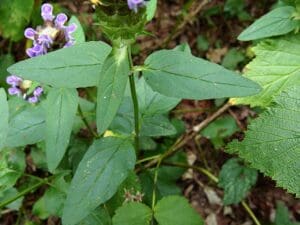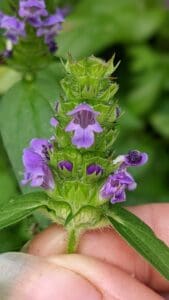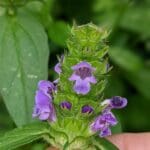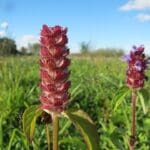Selfheal / Summer / Autumn / Edible
Self Heal is a common and edible member of the Mint family. It’s a creeping, perennial plant with a long history of use in herbal medicine.
Hippocrates said ‘let food be thy medicine and medicine be thy food.’ And this plant is a perfect example of that philosophy.
Common Names
Selfheal, Self-heal, Heal-all, Woundwort, Heart-of-the-earth, Carpenter’s herb, Brownwort, Blue curls
Botanical Name
Prunella vulgaris
Scientific Classification
Kingdom – Plantae
Order – Lamiales
Family – Lamiaceae
Physical Characteristics for Selfheal
Leaves
The leaves are lance-shaped, toothed and have red tips, they grow in opposite pairs along the square stems. Up to 3cm long.

Flowers
The flowers can be pink, blue or purple and they grow on club-like, whirled clusters. They are two-lipped and tubular. The top lip is a purple hood, and the bottom lip is often must paler in colour. Below the flowers are a pair of stalkless leaves that look a little like a collar.

Seeds
The fruits are oblong and purple when ripe and the seed heads quite often remain long after the plant has flowered.
Habitat
It’s quite a common plant, it prefers grassy places such as meadows, woodland edges and roadsides.
Known Hazards
Some people have reported allergic reactions after consuming this plant.
Could be Confused with
Other members of the Mint family, the most similar looking is Bugle (Ajuga reptans) but this has blue flowers and the leaves have a bronze tinge. Bugle is quite rare in the UK but it is also edible.
Edible Uses
All parts of the part are edible. The leaves and shoots can be used raw in salads or cooked as a leafy green.
The leaves, shoots and flowers were traditionally dried and powdered to make a tea.
Notes on Herbal Uses
It has a long history of use in herbal medicine and is typically taken in the form of teas made from the leaves and flowers. It is said to be useful in treating
The plant contains vitamins A, B, C, K, flavonoids, and rutin.
It’s also high in antioxidants and has been the subject of much recent research.
The leaves and stems are said to be antibacterial, astringent, diuretic, hypotensive, anti-tumour and a powerful antioxidant.
The flower spikes have been used for centuries to restore the liver and modern research suggests that the plant does possess hepatoprotective (liver-protecting) properties.
References:
1 reply on “Self heal (Prunella vulgaris) Identification”
Leave a Reply
You must be logged in to post a comment.












Hello! Part of this article is missing, a sentence reads “said to be useful in treating” and then the whole paragraph stops!